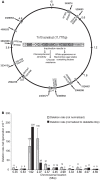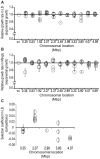Selection-driven gene loss in bacteria - PubMed (original) (raw)
Selection-driven gene loss in bacteria
Sanna Koskiniemi et al. PLoS Genet. 2012 Jun.
Abstract
Gene loss by deletion is a common evolutionary process in bacteria, as exemplified by bacteria with small genomes that have evolved from bacteria with larger genomes by reductive processes. The driving force(s) for genome reduction remains unclear, and here we examined the hypothesis that gene loss is selected because carriage of superfluous genes confers a fitness cost to the bacterium. In the bacterium Salmonella enterica, we measured deletion rates at 11 chromosomal positions and the fitness effects of several spontaneous deletions. Deletion rates varied over 200-fold between different regions with the replication terminus region showing the highest rates. Approximately 25% of the examined deletions caused an increase in fitness under one or several growth conditions, and after serial passage of wild-type bacteria in rich medium for 1,000 generations we observed fixation of deletions that substantially increased bacterial fitness when reconstructed in a non-evolved bacterium. These results suggest that selection could be a significant driver of gene loss and reductive genome evolution.
Conflict of interest statement
The authors have declared that no competing interests exist.
Figures
Figure 1. Chromosomal locations of the Tn_10_ construct and deletion rates.
(A) Schematic representation of the Salmonella typhimurium LT chromosome and the structure and insertion points of the Tn_10_ construct used for measurements of deletion rates. Numbers and arrows outside the chromosome ring indicate the Tn_10_ insertion point. The relative size of the grey box and the numbers on the inside of the ring indicate the size of the deletions isolated in that specific region. When numbers are absent this indicate that the deletions were internal to the Tn_10_ construct. In the middle, the structure and gene content of the Tn_10_ construct and the resulting phenotypes of loss of the cat, moaA and lacZ genes, respectively, are shown. (B) Deletion rates at 11 different chromosomal regions. Standard errors are indicated. The normalization procedure is described in Text S1_ENREF_20. Compare with Figure S4 for a different normalization method (Text S1).
Figure 2. Relative fitness of mutants with deletion of different chromosomal regions.
(A) Relative exponential growth rates (parental strain set to 1.0) in single cultures for mutants with deletion of different chromosomal regions during growth in rich LB medium. (B) Relative exponential growth rates (parental strain set to 1.0) in single cultures for mutants with deletion of different chromosomal regions during growth in minimal (M9) glycerol medium. (C) Selection coefficients of deletion mutants obtained from competition experiments in rich LB medium with an isogenic parental control (defined as s = 0).
Similar articles
- Bacterial genome size reduction by experimental evolution.
Nilsson AI, Koskiniemi S, Eriksson S, Kugelberg E, Hinton JC, Andersson DI. Nilsson AI, et al. Proc Natl Acad Sci U S A. 2005 Aug 23;102(34):12112-6. doi: 10.1073/pnas.0503654102. Epub 2005 Aug 12. Proc Natl Acad Sci U S A. 2005. PMID: 16099836 Free PMC article. - Fitness effects of replichore imbalance in Salmonella enterica.
Matthews TD, Maloy S. Matthews TD, et al. J Bacteriol. 2010 Nov;192(22):6086-8. doi: 10.1128/JB.00649-10. Epub 2010 Sep 24. J Bacteriol. 2010. PMID: 20870772 Free PMC article. - Genome-wide detection of spontaneous chromosomal rearrangements in bacteria.
Sun S, Ke R, Hughes D, Nilsson M, Andersson DI. Sun S, et al. PLoS One. 2012;7(8):e42639. doi: 10.1371/journal.pone.0042639. Epub 2012 Aug 3. PLoS One. 2012. PMID: 22880062 Free PMC article. - Deletional bias and the evolution of bacterial genomes.
Mira A, Ochman H, Moran NA. Mira A, et al. Trends Genet. 2001 Oct;17(10):589-96. doi: 10.1016/s0168-9525(01)02447-7. Trends Genet. 2001. PMID: 11585665 Review. - Neutral mutations and neutral substitutions in bacterial genomes.
Ochman H. Ochman H. Mol Biol Evol. 2003 Dec;20(12):2091-6. doi: 10.1093/molbev/msg229. Epub 2003 Aug 29. Mol Biol Evol. 2003. PMID: 12949125 Review.
Cited by
- Bacterial genome reductions: Tools, applications, and challenges.
LeBlanc N, Charles TC. LeBlanc N, et al. Front Genome Ed. 2022 Aug 31;4:957289. doi: 10.3389/fgeed.2022.957289. eCollection 2022. Front Genome Ed. 2022. PMID: 36120530 Free PMC article. Review. - Annotation-free delineation of prokaryotic homology groups.
Yin Y, Ogilvie HA, Nakhleh L. Yin Y, et al. PLoS Comput Biol. 2022 Jun 8;18(6):e1010216. doi: 10.1371/journal.pcbi.1010216. eCollection 2022 Jun. PLoS Comput Biol. 2022. PMID: 35675326 Free PMC article. - Ab Initio Construction and Evolutionary Analysis of Protein-Coding Gene Families with Partially Homologous Relationships: Closely Related Drosophila Genomes as a Case Study.
Han X, Guo J, Pang E, Song H, Lin K. Han X, et al. Genome Biol Evol. 2020 Mar 1;12(3):185-202. doi: 10.1093/gbe/evaa041. Genome Biol Evol. 2020. PMID: 32108239 Free PMC article. - Enhanced Mutation Rate, Relaxed Selection, and the "Domino Effect" are associated with Gene Loss in Blattabacterium, A Cockroach Endosymbiont.
Kinjo Y, Lo N, Martín PV, Tokuda G, Pigolotti S, Bourguignon T. Kinjo Y, et al. Mol Biol Evol. 2021 Aug 23;38(9):3820-3831. doi: 10.1093/molbev/msab159. Mol Biol Evol. 2021. PMID: 34426845 Free PMC article. - Isolation and Characterization of High-Efficiency Rhizobia From Western Kenya Nodulating With Common Bean.
Wekesa CS, Furch ACU, Oelmüller R. Wekesa CS, et al. Front Microbiol. 2021 Sep 10;12:697567. doi: 10.3389/fmicb.2021.697567. eCollection 2021. Front Microbiol. 2021. PMID: 34566909 Free PMC article.
References
- Zamenhof S, Eichhorn HH. Study of microbial evolution through loss of biosynthetic functions: establishment of “defective” mutants. Nature. 1967;216:456–458. - PubMed
- Dykhuizen D. Selection for Tryptophan Auxotrophs of Escherichia coli in Glucose-Limited Chemostats as a Test of the Energy Conservation Hypothesis of Evolution. Evolution. 1978;32:125–150. - PubMed
- Koch AL. The protein burden of lac operon products. J Mol Evol. 1983;19:455–462. - PubMed
- Barrick JE, Yu DS, Yoon SH, Jeong H, Oh TK, et al. Genome evolution and adaptation in a long-term experiment with Escherichia coli. Nature. 2009;461:1243–1247. - PubMed
- Khan AI, Dinh DM, Schneider D, Lenski RE, Cooper TF. Negative epistasis between beneficial mutations in an evolving bacterial population. Science. 2011;332:1193–1196. - PubMed
Publication types
MeSH terms
LinkOut - more resources
Full Text Sources
Other Literature Sources

